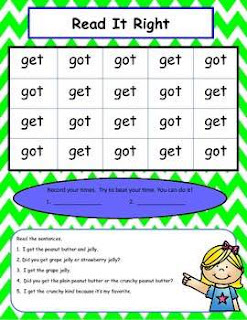Struggling Readers- How to Pinpoint and Prioritize
I read with a struggling fourth grader who was having difficulty with comprehension. There are several reasons for this; decoding, fluency, vocabulary, lack of comprehension skills. Or it could be all of the above. First, determine which skills are not mastered. Then, prioritize which to teach first and have a specific focus to achieve accelerated progress.
I picked an easy book that I love to use. It's one of my testing books from Reading Recovery,(RR Level 8 GR Level E). It's an easy, short book; but one that's full of opportunities for me discover if the child is decoding left to right.
Obviously, it was an easy book for the child, but there were some errors that gave insight on how he processes visual information. For example, the errors wanted/went, board/bar, scrap/soap demonstrated that the reader isn't decoding left to right through words.
 |
| Reading Intervention Binder |
The beginning and endings of these words are the same. The middle parts are different.
I wrote the words on a piece of paper and asked: how are these words the same? How are they different? I asked the child to verbalize the difference so I knew he was looking carefully at the words.
Then I had him read a beginning third grade passage. He made the same kinds of decoding errors, but he noticed his errors when it didn't make sense and reread and self-corrected. However, with all of that rereading and self-correcting, he was working way too hard. This has a negative impact on comprehension.
The priority with this reader is to give him some practice at the word level; comparing words that have the same beginning and ending sounds but different vowels. For example, get/got/gut; let/lot/lit. Then, I would work on words like fat/fast/fit/fist, let/left/lit/lift/list. Show him examples where he has to look carefully left to right. Some more examples are back/black/beak/bleak......
The decoding has to be addressed first because it's a crack in his foundation. Providing reading passages at an easy level will then give him the opportunity to practice decoding quickly and accurately and build his confidence.
If a reader doesn't improve decoding skills after 3-4 weeks of explicit decoding instruction, then another intervention might be necessary and you should talk with your reading specialist or special education coordinator.
Teacher Tip
Toward the middle of first grade, readers look at the beginning and ending of words and "guess and go". This is effective at this level and a good strategy. As they continue to develop their reading skills, most children discover that they have to look at the middle of words and begin to decode left to right through words. However, there are some students who continue to "guess and go" while ignoring the middle parts of words which becomes a bad habit that has to be broken.
The wise old uncle smiled at the small, proud mouse.
The wise old uncle smelled at the small, proud mouse.
Once I had a third grade student who read smelled for smiled and asked me why the wise old uncle smelled at him- didn't he take a bath? :)
Thanks for reading!
Karen




0 Comments:
Post a Comment
Subscribe to Post Comments [Atom]
<< Home